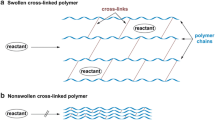Abstract.
An understanding of very complex natural systems can often only be achieved through detailed studies of systems with a reduced complexity. Thus, de novo design of proteins allows the study of fundamental forces determining protein folding and stability, as well as protein-protein interactions, by analyses of protein models of structural motifs. In addition, de novo design may lead to new biomimetic molecules with novel properties. In a synthetic approach to achieve structural economy, rigid templates, sometimes called topological scaffolds, have been used to connect secondary-structure elements, most notably α-helices. By positioning the helices on the template, the unfavorable entropy of protein folding is reduced. In a novel class of chimeric molecules called carboproteins, carbohydrates are used as templates for de novo design of protein models. Recently, a strategy relying on chemoselective ligation of C-terminal peptide aldehydes to tetra-aminooxy functionalized monosaccharides has provided 7-kDa 4-α-helix bundle carboproteins.
Similar content being viewed by others
Author information
Authors and Affiliations
Corresponding author
Additional information
Received 14 November 2001; received after revision 10 December 2001; accepted 10 December 2001
Rights and permissions
About this article
Cite this article
Jensen, K., Brask, J. Carbohydrates as templates for control of distance-geometry in de novo-designed proteins. CMLS, Cell. Mol. Life Sci. 59, 859–869 (2002). https://doi.org/10.1007/s00018-002-8473-z
Published:
Issue Date:
DOI: https://doi.org/10.1007/s00018-002-8473-z




